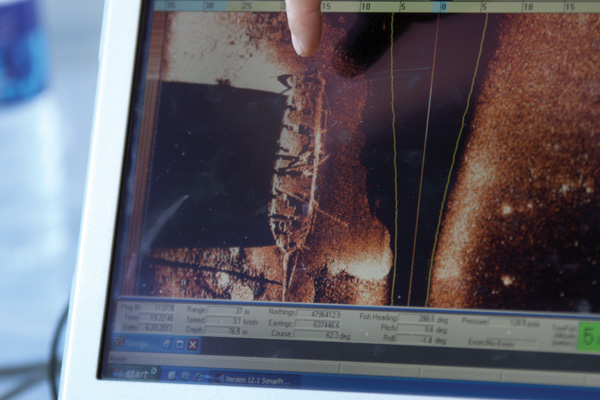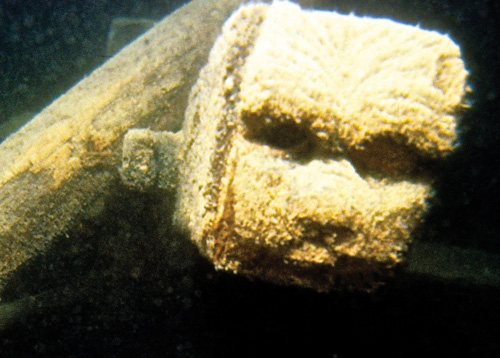Bicentennial Survey a First
First magnetometer survey of Hamilton and Scourge may reveal new debris field artefacts of the Lake Ontario heritage wrecks
Text and Photos by Joseph Frey

Sailing out of Ontario’s historic Port Dalhousie on a glorious late June morning I imagine the treed shoreline of western Lake Ontario looks much as it did August 8, 1813, when the U.S. Navy ships, Hamilton and Scourge, capsized in a squall and sank with heavy loss of life.
In this bicentennial year of their sinking our mission is a side-scan sonar and first-ever magnetometer survey of the wreck sites. I’m aboard the Parks Canada vessel Investigator with Chriss Ludin at the helm and the agency’s senior marine archaeologists Jonathan Moore and Ryan Harris. Moore oversees the Hamilton and Scourge survey, while Harris heads up the search for the John Franklin ships lost in the Canadian Arctic. Another member of our team is filmmaker Peter Rowe who is directing and producing a film on the sinking of the Scourge, based on accounts given by Ned Myers, one of few sailors who survived the sinking (see sidebar page 44).
Located in 1973 in a search initiated by St. Catharines, Ontario, dentist Dr. Dan Nelson, the Hamilton and Scourge over the years have attracted undersea luminaries that include Jacques Cousteau (1980), National Geographic’s Emory Kristof (1982) and Robert Ballard (1990).

The June survey was conducted in partnership with the City of Hamilton, which has owned and managed this National Historic Site since 1980, and which also initiated the condition survey fieldwork of 2007, 2008 and 2009, with technical/archaeological lead by Parks Canada’s Underwater Archaeology Service and ASI Group Ltd. of nearby St. Catharines. These sonar/ROV surveys produced hundreds of still photos, dozens of hours of video, 3D site mapping by sonar, and ROV penetration dives revealing, in particular, the interior of the Hamilton. Earlier, technical divers had reported mussel colonization on the wrecks and samples collected during the condition surveys determined the species as quagga mussels.
The magnetometer survey generates a magnetic anomaly map of the study area. “It adds another class of data that has not been exploited to date and could reveal something new or unexpected,” Moore said. “I’ve wondered about material lost overboard during the initial knock down of the schooners and if there’s any trace of this on the lakebed, beyond what we already know is there. The magnetometer detects debris zones thereby helping to locate knock down positions,” he said. “Logically, heavy materials such as cannon balls have survived on the lakebed where they may be detectable today.”
This summer’s expedition also used high-resolution side-scan sonar. Initial assessment of this data did not reveal any major or obvious site change at a detectable scale. “For example, the masts standing on both wrecks in 2009 were still standing in 2013,” Moore said, noting that there are two on Scourge and one on Hamilton, whose foremast was torn off in 1982.
Moore said the mussel coverage of the lakebed and of artifacts there is about the same. “A careful review of the sonar data should tell us more of the disposition of other features such as any obvious movement of ordnance on the ships’ decks.”

Quagga-mire
Over the past couple of decades quagga mussels were introduced to the Great Lakes from Europe via ship bilge water. This invasive species is now widespread and covers the lakebed around Hamilton and Scourge. Side-scan sonar images reveal that the starboard side of Scourge is blanketed so heavily that any view of the hull, deck, cannons and other artefacts is obstructed. The mussels will eventually envelope both vessels.
The 1982 expedition by Emory Kristof, Chris Nicholson, Dr. Dan Nelson, Martin Bowen and Randy Weldon documented both ships before the infestation, as some of the accompanying pictures attest. The largest collection – 2,000 plus – of the best photographs taken to date of the wrecks, as well as colour video come from that expedition, Moore said. “The high quality colour slides of both wrecks – it was the first time Scourge was imaged – show in great detail the schooners as if frozen in time,” he said. “It’s an appropriate cliché in the case of these wrecks because they were used extensively by researchers who created several sets of archaeological site plans.” He said the images were especially valuable today, considering the mussel colonization that now covers and obscures most of the features photographed in 1982. All the 1982 slides have now been digitized.
Quagga mussels have killed the feasibility of raising the ships as seen with Sweden’s Vasa and England’s Mary Rose but the extensive research of Hamilton and Scourge could be the basis for construction of full scale replicas. The knowledge base on the wrecks since their location by Dr. Daniel Nelson is the result of many organizations, some of which still play a role in either the exploration, research, mapping, conservation, management, archiving or storytelling of these archaeological treasures. They include the City of Hamilton, National Geographic Society, Aqua Probe Limited, Parks Canada, ASI Group, Canadian Conservation Institute, United States Navy, Royal Canadian Navy, Canadian Coast Guard, Canadian Hydrographic Service, Royal Ontario Museum, YAP Films and Peter Rowe Productions Inc.
To read DIVER magazine’s in depth article on the Hamilton and Scourge wrecks, click here.







